Service and combat use of the German repeating rifle Mauser 98k after the end of World War II
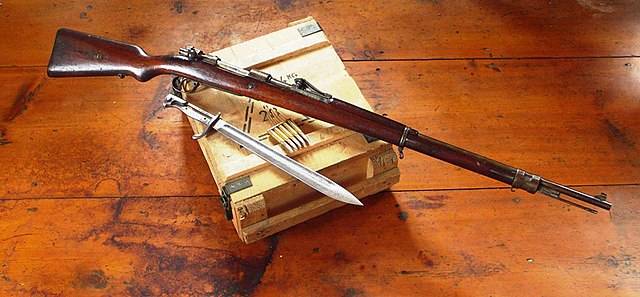
As trophies, the countries that won World War II received a total number of German magazine rifles sufficient to fully equip the armies of several European states with them. Subsequently, these rifles chambered for 7,92 × 57 Mauser remained in operation for decades and were a reserve in case of a major war.
In the post-war period, the production of German-style rifles continued in a number of countries, and they were actively exported. Part of the rifles sold on the foreign market ended up at the disposal of various kinds of irregular formations and national liberation movements. Bolt-action K98k rifles, despite their very advanced age, are still popular with hunters and are offered for sale to private individuals.
Rifle Mauser 98k
After the end of World War I, the German armed forces had 7,92 mm rifles and carbines developed by Gebrüder Mauser und Cie: Gewehr 98, Karabiner 98a and Karabiner 98b.

Gewehr 98 rifle
There were also some old Gewehr 1888s and Karabiner 88s in stock.

Gewehr 1888 rifle
The Gewehr 98 rifle and the carbines based on it differed from the Gewehr 1888 model in an improved bolt and feeder design, as well as a modified way to fill the magazine box.
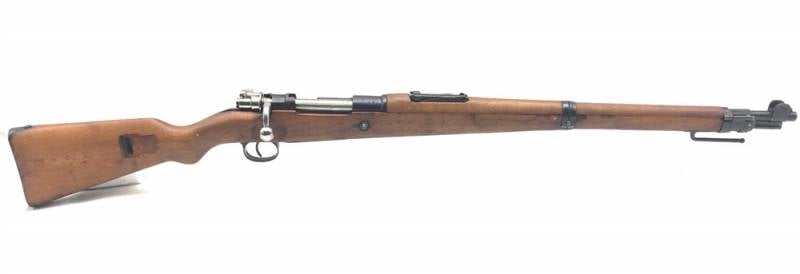
Carbine Karabiner 98a
In 1935, the 7,92 mm Mauser 98k rifle, better known as the Karabiner 98k or K98k, entered service. This rifle used successful technical solutions previously implemented in the Standardmodell (Mauser Model 1924/33) and Karabiner 98b models. Despite the name Karabiner 98k is weapon was a full-fledged infantry rifle, and was comparable in length to samples available in other countries.

Rifle K98k
Compared to the original Gewehr 98 adopted in 1898, the improved K98k had a shorter barrel (600 mm instead of 740 mm). The length of the stock was slightly reduced, and a notch appeared in it for the bolt handle bent down. Instead of the "infantry" Gewehr 98 sling swivels on the K98k, the front swivel is combined in one piece with the rear stock ring, and instead of the rear swivel there is a through slot in the butt. A new bayonet-knife SG 84/98 was introduced, significantly shorter and lighter than the bayonets used on earlier models. The K98k rifle was equipped with a short ramrod.
In order to clean the bore, two ramrods must be screwed together. The wooden stock has a semi-pistol grip, typical for hunting weapons. The steel butt plate is made with a door that closes the compartment for accessories to weapons. In order to reduce the cost of manufacturing in 1937, wooden parts began to be replaced with laminate.
Since 1940, the Gebirgsjägerkarabiner Gewehr 33/40 carbine has been produced for mountain rifle troops and paratroopers at the Waffenwerke Brünn enterprise in the Czech Republic with a barrel length of 490 mm, total length - 995 mm, weight without cartridges - 3,5 kg.
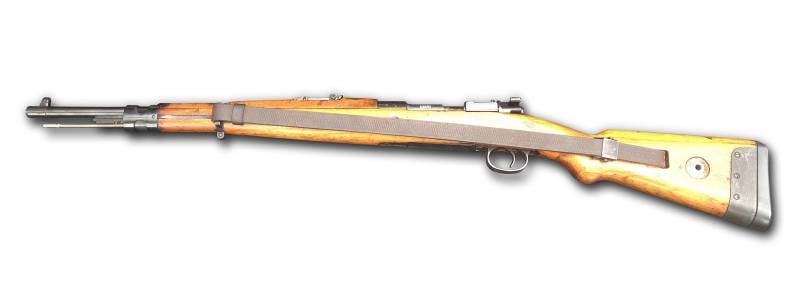
Carbine Gebirgsjägerkarabiner Gewehr 33/40
The Mauser Oberndorf factory delivered a small number of carbines with a folding butt (Klappschaft) and with a removable barrel (Abnehmbarer Lauf) by military standards.
At the end of 1944, production began on a simplified version of the K98k, known as the Kriegsmodell ("military model"). This modification had a number of changes aimed at reducing the cost and labor intensity of production with some deterioration in the quality of workmanship and finish. The resource of the barrel has also decreased and the accuracy of shooting has deteriorated.
The production of K98k rifles was carried out at ten enterprises in Germany, Austria and the Czech Republic. In addition, the K98k was produced in Sweden, Argentina, Spain, Iran, Peru, Chile and Mexico with minor modifications and sometimes chambered in a different caliber.
In total, from 1935 to 1945, German enterprises and factories in the occupied territories handed over more than 14 million rifles. To this number must also be added the Mauser rifles produced in Germany before 1935 and captured in other countries.
Depending on the manufacturer and year of manufacture, the weight of the rifle was 3,8–4 kg. Length - 1 110 mm. The K98k was typically fired using the 7,92x57mm sS Patrone cartridge, originally designed for long-range use, with a heavy 12,8g pointed bullet. Muzzle velocity of about 760 m/s. Muzzle energy - 3 J. An integral box-shaped double-row magazine with a capacity of 700 rounds is located inside the box.
The magazine is loaded with cartridges with the shutter open through a wide upper window in the receiver from clips for 5 rounds or one cartridge each. Sights consist of a front sight and a sector rear sight, adjustable in firing range from 100 to 1 meters.
A well-trained shooter is capable of firing 12 aimed shots per minute. The effective range of fire at point targets with mechanical sights was 400–450 m. A sniper rifle with a telescopic sight could hit the same targets with a high probability at a distance of up to 700 m. Rifles with the best accuracy of combat were selected for the installation of optical sights.
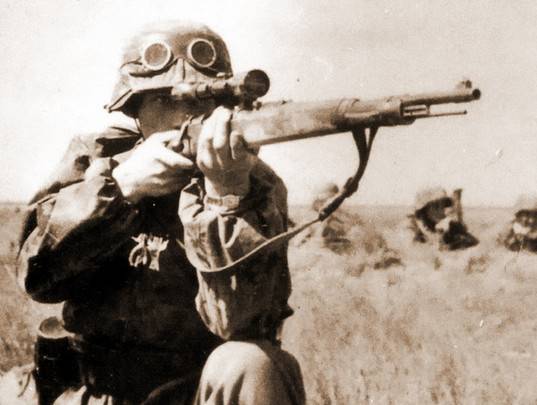
The most commonly used quadruple sights ZF39 or simplified 41x ZF1943. In 43, the ZFXNUMX quadruple telescopic sight was adopted.
In total, about 132 sniper rifles were produced for the German armed forces.
In the spring of 1942, the Gewehrgranat Geraet 42 rifle grenade launcher entered service, which was a 30-mm mortar mounted on the muzzle of the rifle. The grenades were fired with a blank cartridge. The effective range of firing with cumulative anti-tank grenades was 40 m, armor penetration along the normal was up to 70 mm.
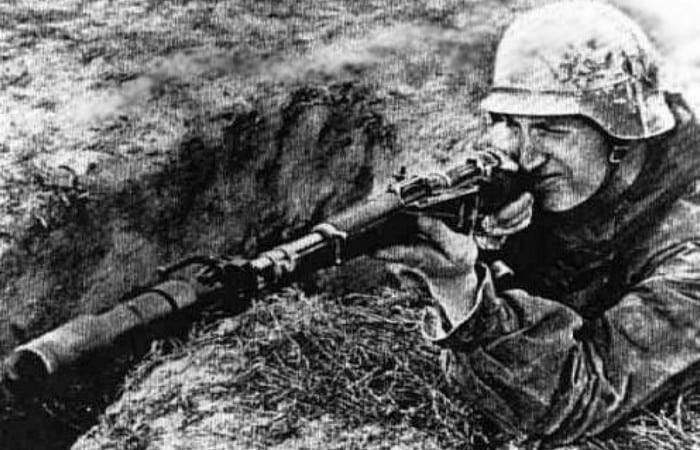
On the muzzle of the K98k rifle, a HUB23 sound suppressor could also be mounted, paired with a special Nahpatrone cartridge. Ammunition with an initial bullet speed of 220 m/s ensured a confident defeat of a growth target at a distance of up to 200 m.
The K98k rifle is one of the best bolt-action repeating rifles. It has high reliability, durability and long service life, is easy and safe to use.
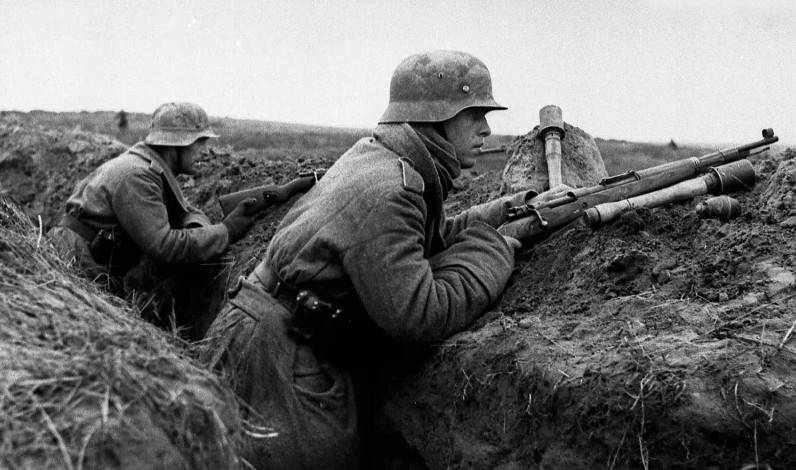
By the time of the attack on the USSR, the actions of the infantry squad of the Wehrmacht were built around the MG 34 machine gun, which was served by three people. Non-commissioned officers could be armed with MP 28 or MP 38/40 submachine guns, and six shooters with K98k rifles.
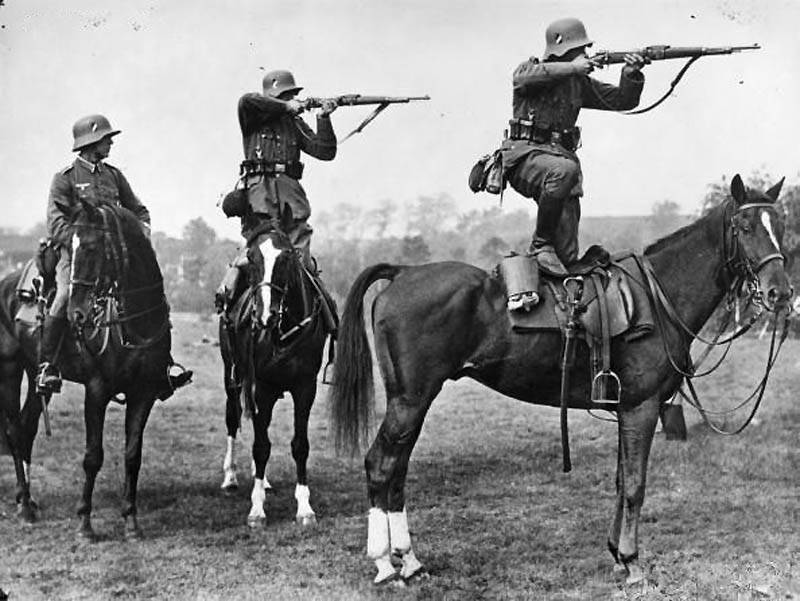
During World War II, the K98k rifle was the most numerous type of small arms in the armed forces of Nazi Germany and was widely used by various branches of the military in all theaters of war.
Post-war production of Mauser 98k rifles
In 1946, Mauser's production facilities in Oberndorf ended up in the French zone of occupation, after which the industrial equipment was removed. There is information that weapons were assembled from the unused reserve under the control of the occupying authorities, which then entered the French armed forces and police forces or were sold on the foreign market.
The Mauser plant, located in the vicinity of Berlin and found itself in the Soviet zone of occupation, continued to produce rifles, which armed units of the barracks people's police of the GDR.
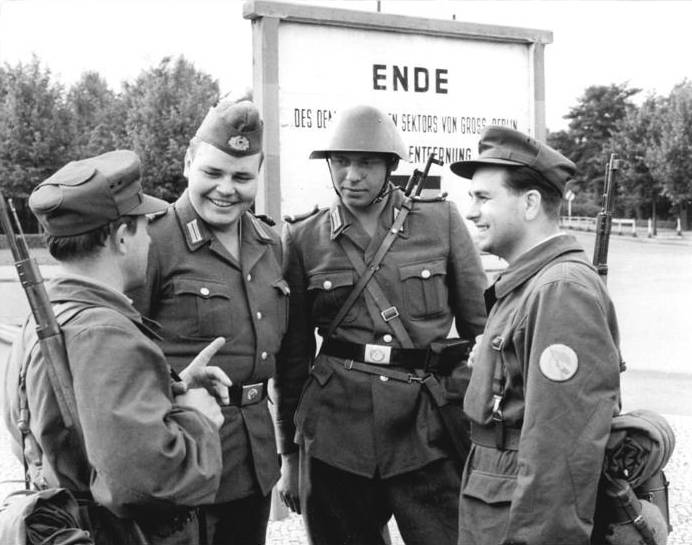
Newly manufactured and used K98k rifles were equipped with the paramilitary units of the Kampfgruppen der Arbeiterklasse (German: “Combat groups of the working class”), which were considered a trained combat-ready reserve and were armed mainly with small arms.
English-language publications write that in the late 1940s and early 1950s, a Czechoslovak enterprise Zbrojovka Brno, which during the years of occupation was called Waffenwerke Brünn, handed over a certain number of 7,92-mm rifles. However, it is not clear whether these weapons were made from new parts, or whether components released earlier were used for assembly.
The largest manufacturer in the post-war period was the Yugoslav enterprise Crvena Zastava. New rifles had the designation M-48, and assembled from parts produced in Germany, or overhauled German copies were called M-98/48. Rifles M-48 and M-98 / 48, along with authentic captured K98k, entered the infantry units of the Yugoslav People's Army. Western authors write that Yugoslav-made Mausers did not differ from German ones in their characteristics.
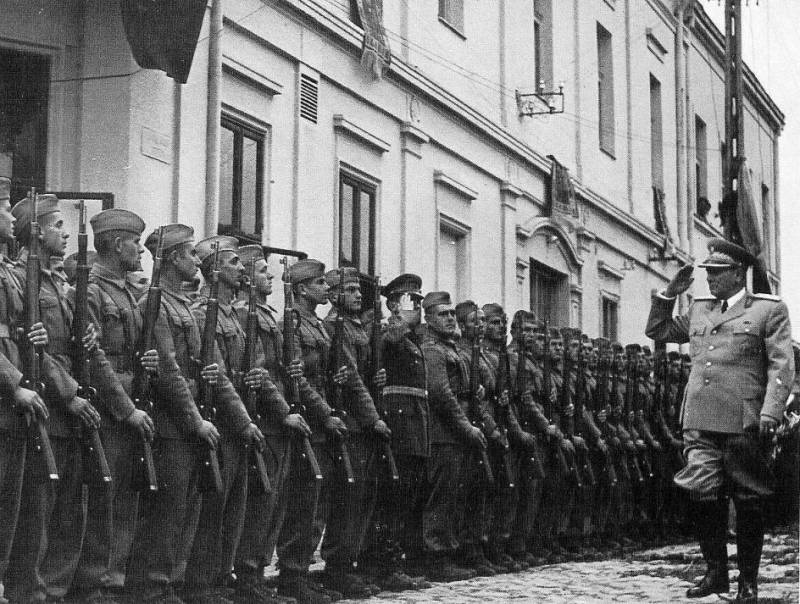
In the modification of the M-48A, which appeared in 1952, changes were made to reduce the cost and simplify the production process.
In 1956, the Crvena Zastava plant began to produce the M-48B model, on which some parts were stamped. Nevertheless, these rifles were not inferior in quality to the German ones.

Rifle M-48VO
The export model is known as the M-48VO, it differed from the M-48V by the absence of markings and a serial number on the receiver, which should have been applied in the buyer's country. Part of the export rifles, at the request of the customer, was marked at the manufacturer. The production of 7,92 mm Mausers in Yugoslavia continued until 1965. The customers of the M-48VO rifles were Egypt, Myanmar, Syria, Indonesia and Iraq.
Some countries that had K98k rifles in their armies in the post-war period converted them to suit their needs. So, in the 1950s, Norway adapted most of the rifles produced in Germany for the American cartridge .30-06 Springfield (7,62 × 63 mm).
After the 308 Winchester (7,62 × 51 mm), also known as 7.62 NATO, was adopted as the standard rifle and machine gun cartridge in the North Atlantic Alliance, a number of states converted their Mausers in the late 1950s and early 1960s under NATO ammunition.
Post-war use of Mauser 98k rifles
After the end of World War II, about 3 million German rifles suitable for further use accumulated in Soviet warehouses. Our troops also captured about 2 billion 7,92-mm rifle cartridges, and the German K98k, transferred to storage bases, became a reserve in case of a new war. If necessary, captured rifles suitable for further use were repaired, after which they were taken into account and preserved.
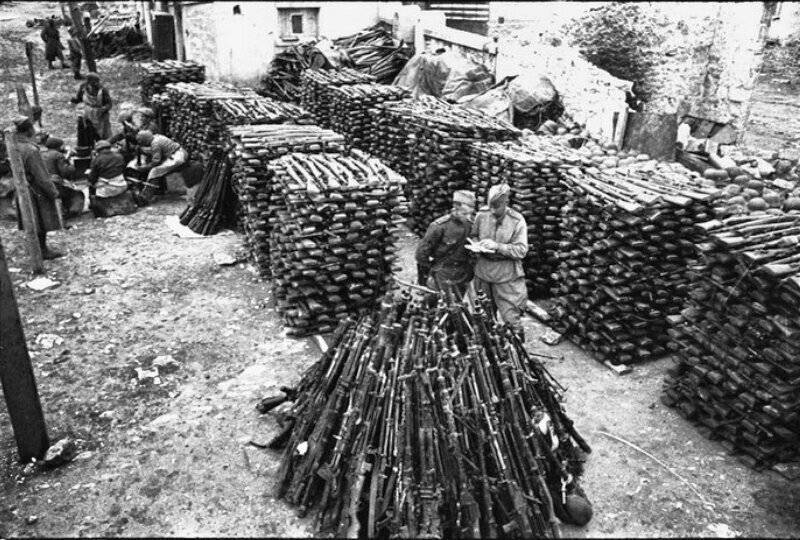
A large number of German rifles remained in the territories liberated by the allies in the anti-Hitler coalition.
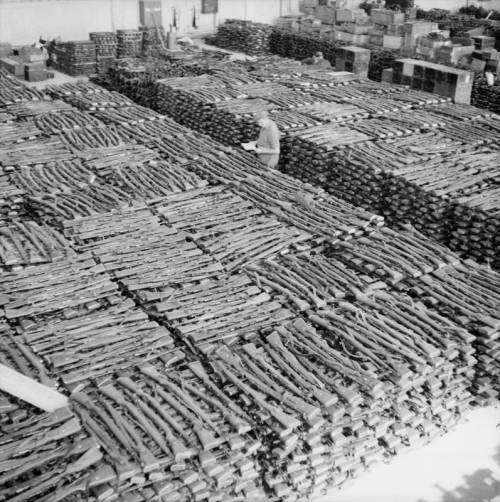
Warehouse of captured weapons at the Sola airfield, Norway. 1945
The original German K98k rifles, as well as their clones made in other countries, were in active operation for more than 20 years after the end of the war, and in some places they made it to the XNUMXst century in reserve. In a number of states, they are still used as ceremonial carbines.
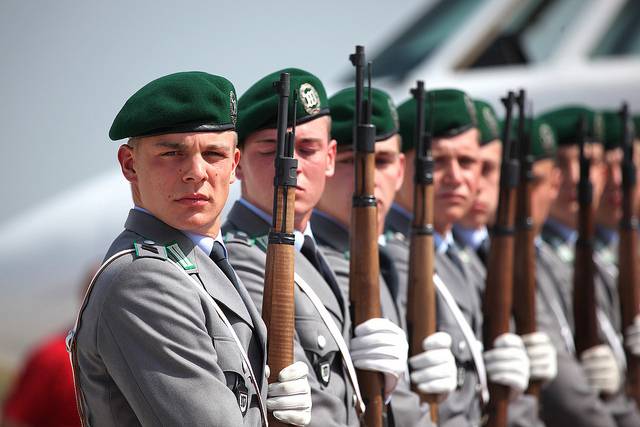
In the post-war period, small arms produced in the Third Reich, due to their cheapness, were popular on the world market. Poor states actively bought German rifles, which had good service and operational and combat characteristics.
Despite the fact that in the post-war period many semi-automatic and automatic models of individual small arms appeared, 7,92-mm Mausers were in service with the armies of many states in Europe, Asia, Africa, Central and South America and Middle East.
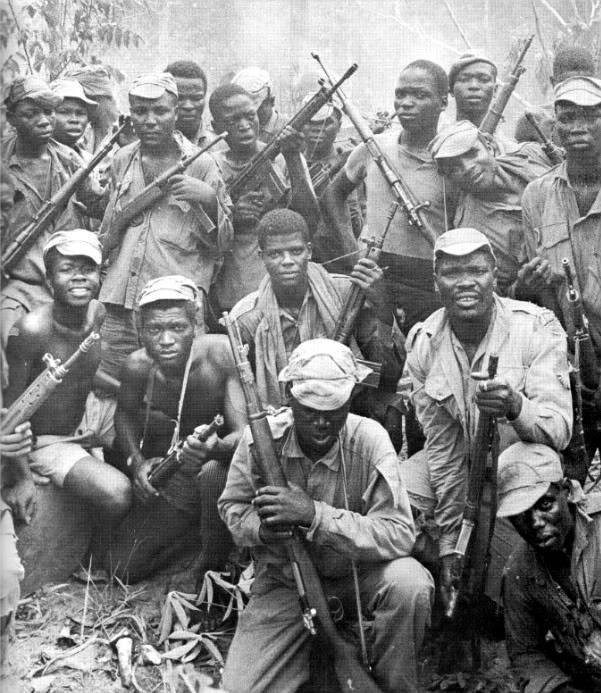
In parallel with other assault rifles and repeating rifles, the K98k was actively used in anti-colonial armed conflicts.
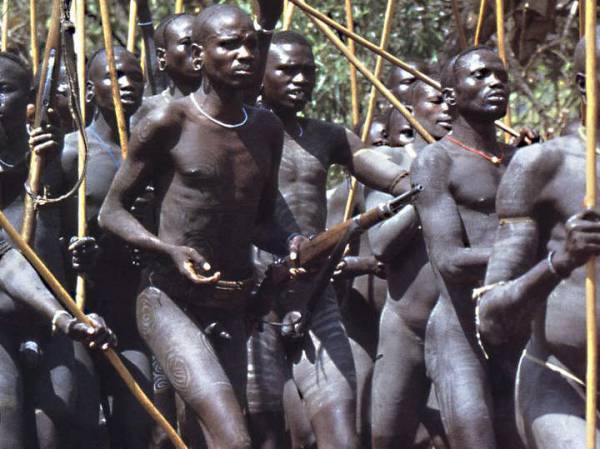
Sometimes they could be seen in the hands of completely naked warriors, in addition to firearms, armed with spears.
The Soviet Union handed over some of the captured German weapons to the Allies. The first recipient of a large batch of captured K98k was the communist People's Liberation Army of China, leading an armed struggle against the National Revolutionary Army of the Kuomintang.
Taking into account the fact that in China since the 1930s the licensed production of German rifles and 7,92-mm cartridges has been carried out, there were no problems with the development of captured K98k delivered from the USSR. A significant number of K98k rifles during the years of the Korean War were available both to the DPRK army and to the Chinese volunteers. In the armed forces of mainland China and North Korea, Mauser rifles were used until the mid-1960s and were in reserve until the late 1980s.
The French armed K98k rifles with auxiliary units and native units that fought on the side of the colonial administration in Indochina and Algeria. The police forces of the Prefecture of Paris and the Republican Security Corps until 1992 used German K98k along with French MAS Modèle 36 rifles equipped with rifle grenade launchers to fire tear gas grenades.
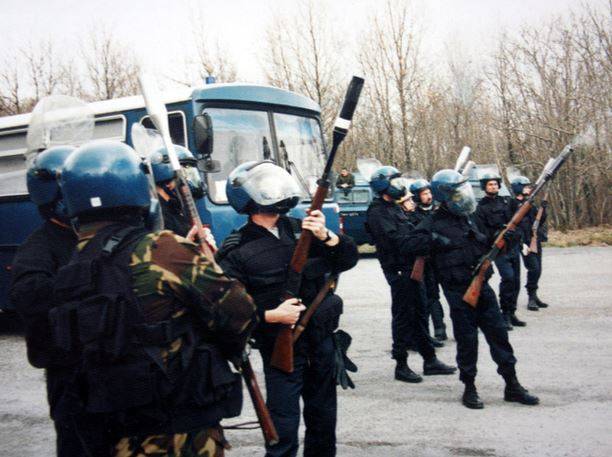
Mauser rifles chambered for 7,92 × 57 mm actively fought in Indochina from the second half of 1940 to the end of the 1970s.

These were rifles transferred by the Soviet Union and China, as well as captured from formations that fought on the side of the French.
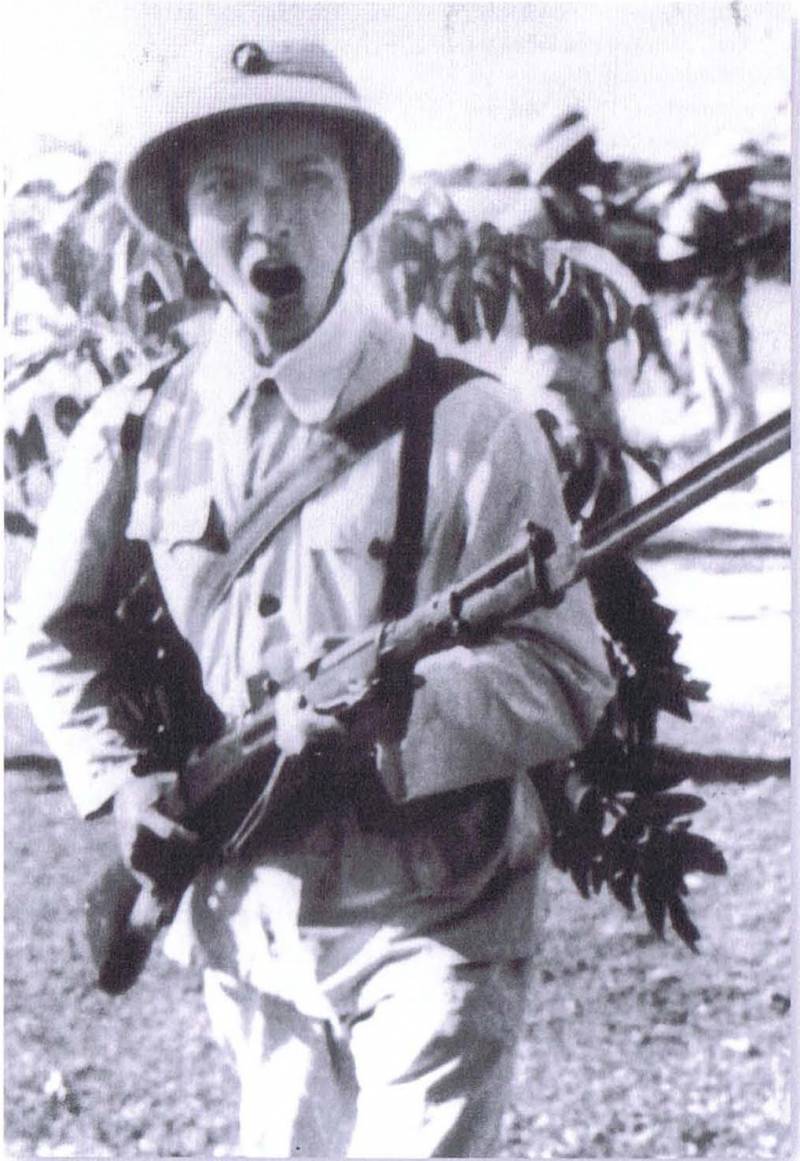
Mauser rifles were armed with a significant part of the North Vietnamese army and guerrillas operating in the south of the country, and since the mid-1960s these weapons have been used against American troops.
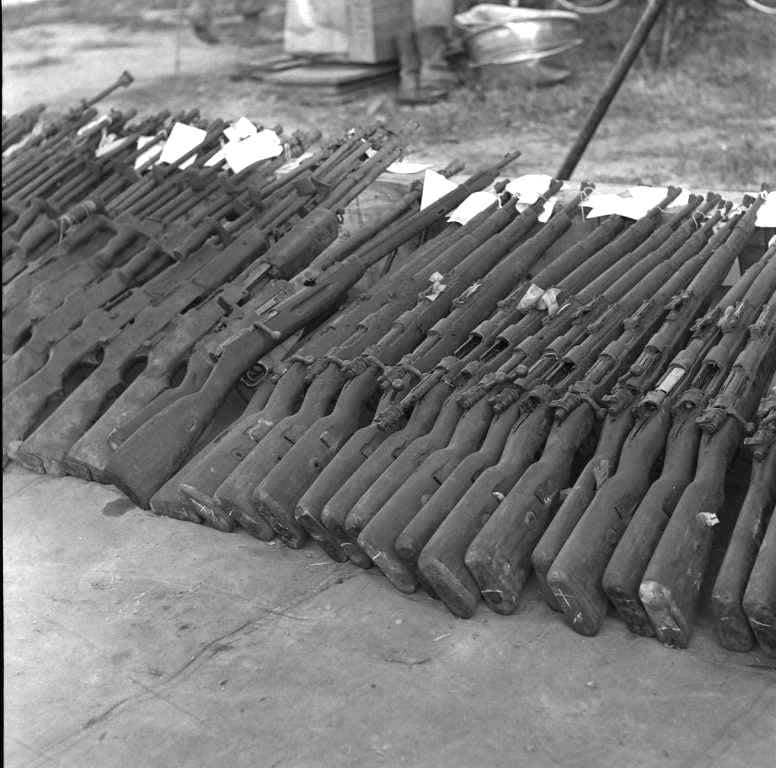
Often, German, Czechoslovak, Polish and Chinese-made Mauser rifles became American trophies, and they were handed over to the troops of South Vietnam.
It is noteworthy that small arms, which were previously in service with the Wehrmacht and the Waffen-SS, at the initial stage played a significant role in ensuring the defense capability of the Jewish state.
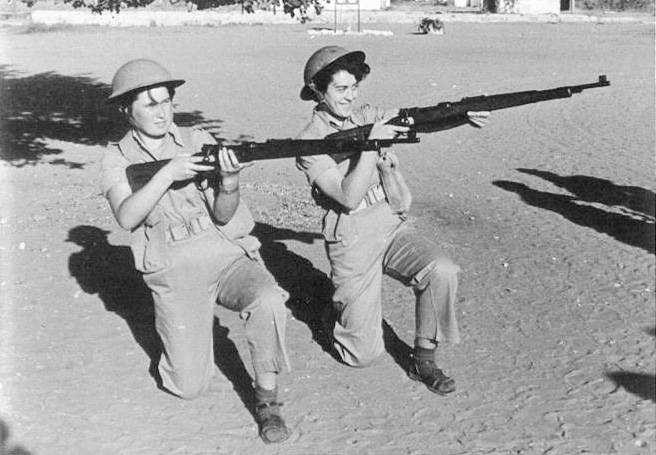
Repeating rifles of 7,92 mm caliber until the mid-1970s were the weapons of Israeli reservists.
In January 1948, Israel signed a contract with Czechoslovakia for the supply of 4 Czech and German-made K500k and vz.98 rifles, as well as 24 million rounds of ammunition. In total, Czechoslovakia supplied Israel with 5 rifles, more than 25 machine guns and over 000 million rounds of ammunition.
Portugal in the early 1950s acquired several tens of thousands of used K98k rifles, which were subsequently armed with personnel involved in counterguerrilla operations in Africa from 1961 to 1974. In the Portuguese army, German rifles were designated Espingarda 8 mm Mauser m/938.
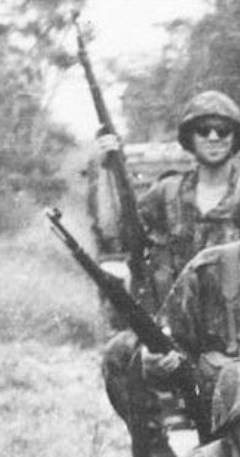
Shop "Mausers" in parts of the first line in the second half of the 1960s were replaced by automatic rifles G3 and FN FAL. But Mauser m / 938 remained in service with auxiliary, police and native units until the end of the colonial wars. A significant number of magazine rifles fell into the hands of the partisans and were used against the former owners.
In the second half of the 1930s, the Afghan government carried out military-technical cooperation with Germany, and 7,92-mm rifles were officially in service with the Afghan army. In the early 1950s, Afghanistan acquired a large batch of used German-made weapons, as well as 7,92 mm cartridges.
After the entry into Afghanistan of a "limited contingent" K98k often fired on Soviet soldiers and the Afghan military. However, the rebels still had fewer German rifles than the British Lee-Enfield and Soviet Mosin rifles of the 1891/1930 model.
Small arms produced in Nazi Germany, Czechoslovakia and Yugoslavia were used by Arab countries in wars with Israel from the late 1940s to the mid-1960s. 7,92-mm magazine rifles were available in the armies of all Arab states that were part of the anti-Israeli coalition. In the late 1980s, most of the Mauser rifles were transferred to storage.
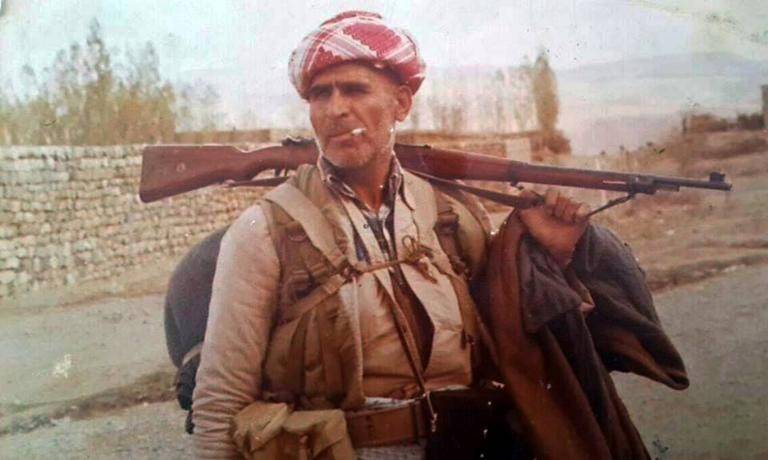
However, a certain number of German K98k, as well as Yugoslav and Czechoslovak clones, remained in service with auxiliary army units, border guards and irregular formations.
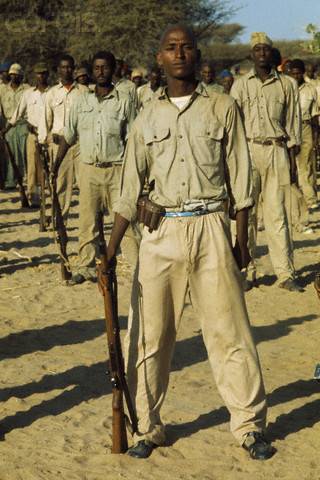
There is a photograph taken in the 1980s of Iraqi dictator Saddam Hussein posing with a Yugoslav-made rifle.
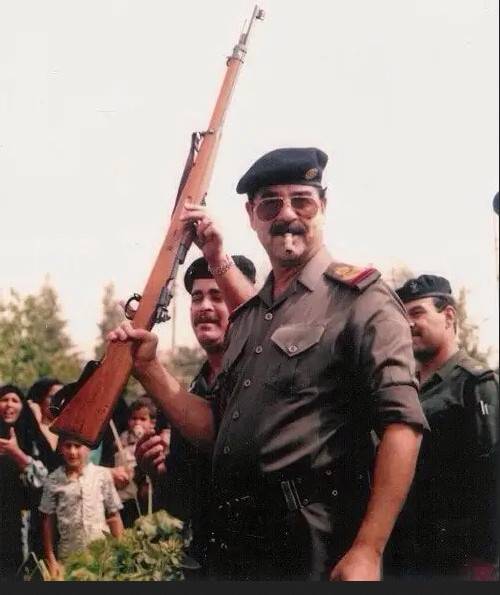
During the Iran-Iraq war, a significant number of Iranian rifles and machine guns chambered for 7,92 × 57 mm were captured by Iraqi forces.
In 2003, former Iranian machine guns and 7,92-mm rifles, as well as the Yugoslav M-48VO and the original German K98k, were confiscated by American soldiers from members of the Fedayina Saddam paramilitary groups.
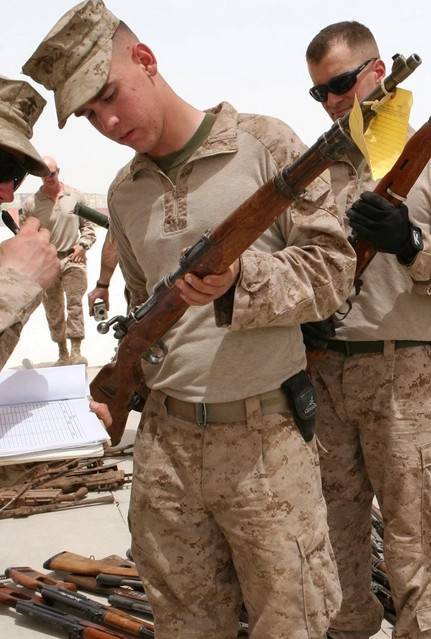
K98k rifle captured by the USMC in 2003 in Iraq
In addition to the relatively "fresh" Yugoslav, Iranian and German Mauser rifles, the US military captured the very rare Gewehr 98, produced in Kaiser's Germany.
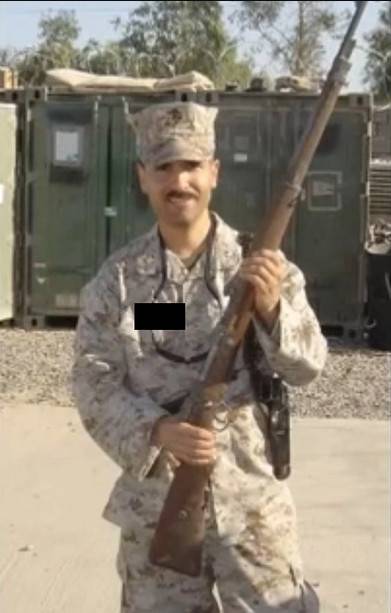
After Baghdad was taken by US troops in April 2003, most of the Iraqi arsenals were left unguarded. According to Western data, more than 130 armories were looted, in which many magazine rifles were stored.
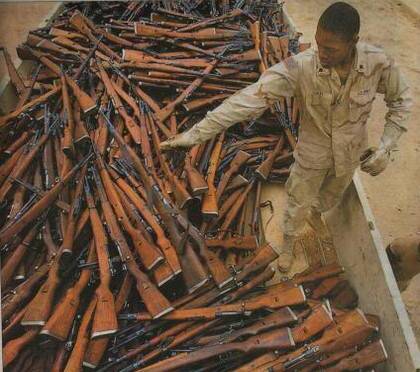
Later, some of the weapons were seized and destroyed, but a certain number of Mausers fell into the hands of the Islamists. Apparently, these were rifles captured not only from Iraqi, but also from Syrian storage bases.
Sometimes quite exotic specimens came across. So, during one raid, the Americans discovered a cache with a sniper rifle, which was a heavily modified K98k.
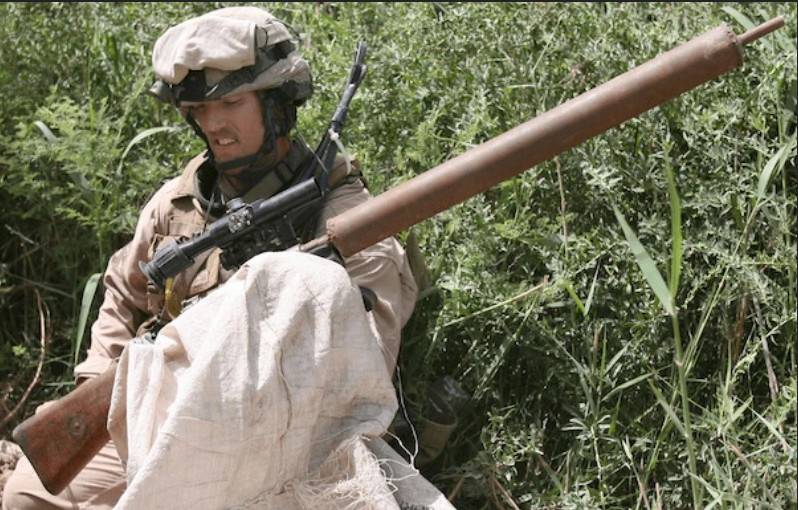
The weapon had a new barrel with a silencer and a PSO-1 optical sight taken from a Soviet SVD sniper rifle.
Modern use of K98k rifles and hunting carbines based on them
Currently, most of the rifles made in the Third Reich are out of service. So, recently there were photographs taken in one of the North African countries, which depict stacks of Mauser magazines.
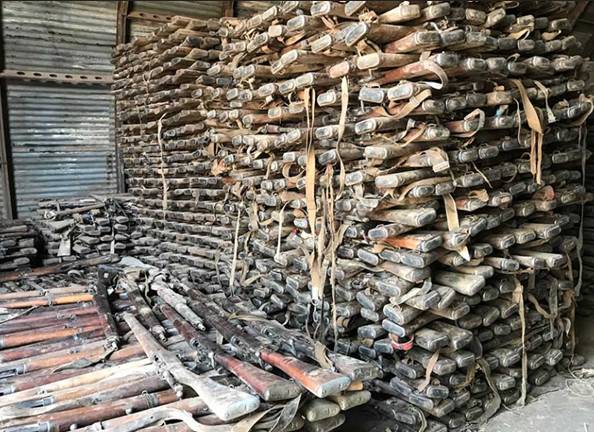
It can be seen that due to improper storage conditions, these rifles are in poor condition and are hardly suitable for further use.
A certain number of K98k, for firing from which the original 7,92 × 57 Mauser cartridges are used, remained in service with police and auxiliary units in third world countries. Rifles converted to 7.62 NATO ammunition are also operated there.
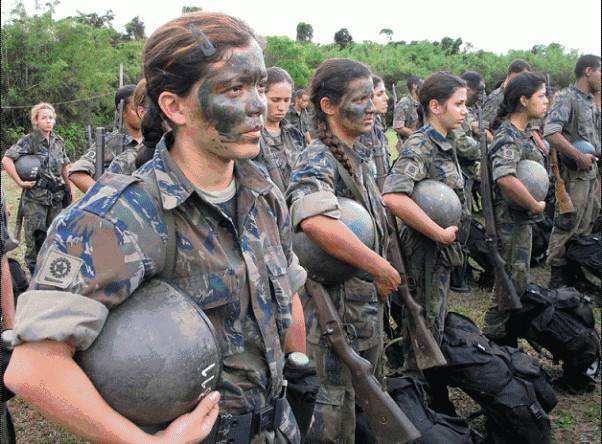
Such an enviable longevity is explained by the large resource, safety margin and high reliability of the K98k. At the same time, it is quite obvious that the rifle, which was put into service in 1935, is hopelessly outdated and is largely used involuntarily.
However, old magazine rifles, with little wear and tear and proper care, often demonstrate very good shooting accuracy, and various irregulars often use them as snipers.
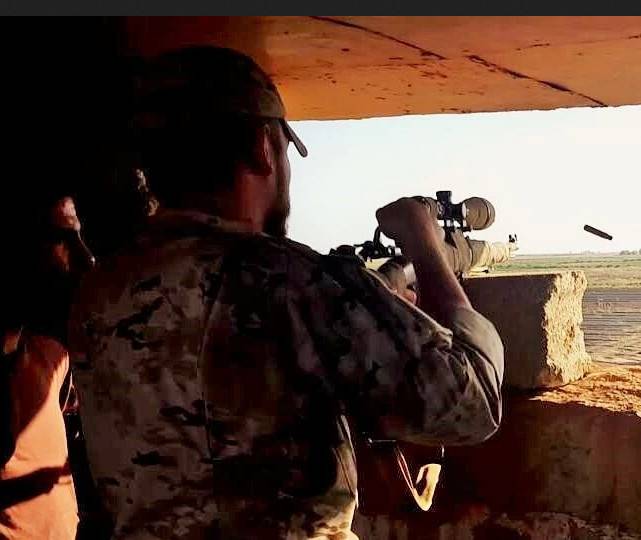
A Kurdish militia sniper fires at Islamic militants. His K98k rifle is equipped with a Zeiss civilian hunting scope. The picture was taken in northern Iraq in 2016.
As mentioned above, the K98k rifles remained in the companies of the guard of honor. This is due to the fact that modern machine guns do not fit well with the dress uniform of soldiers meeting honored guests or participating in ceremonial events.
Serviceable rifles with original stamps and parts, produced during the war years, are in steady demand among collectors. Their demand among buyers is explained by the fact that many want to touch stories and have rare weapons from which you can shoot at targets.
Until now, a significant number of former German rifles are used for hunting. So, in Russia, under the name KO-98M1, customers are offered the original K98k.
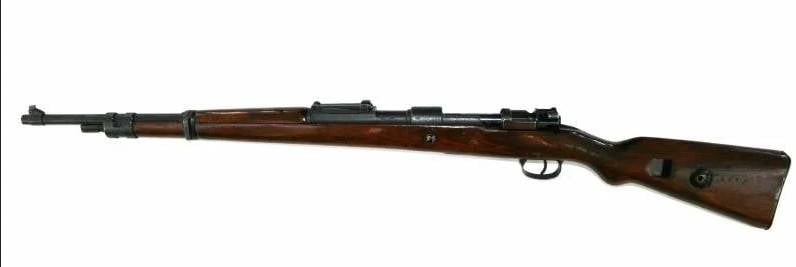
Hunting carbine KO-98M1
Also on sale are: KO-98 - a carbine chambered for .308 Win (7,62 × 51 mm). VPO-115 - carbine chambered for .30-06 Springfield (7,62 × 63 mm). VPO-116M - carbine chambered for .243 Winchester (6,2 × 52 mm).
Since the late 1990s, Mauser Jagdwaffen GmbH, a subsidiary of SIG Sauer Corporation, has been producing Mauser M 98 and M 98 Magnum hunting carbines, which are structurally similar to the K98k rifle in many respects, but have a number of improvements, stock and stock made of fine wood.
The Mauser M 98 series carbines are chambered in 7x57mm Mauser, .308 Winchester, .30-06 Springfield, 8x57 IS and 9,3x62mm. The weight of the unloaded weapon is 3,6 kg. Barrel length - 600 mm. The total length is 1 mm. The magazine capacity is 130 rounds, while the barrel can hold one more round.
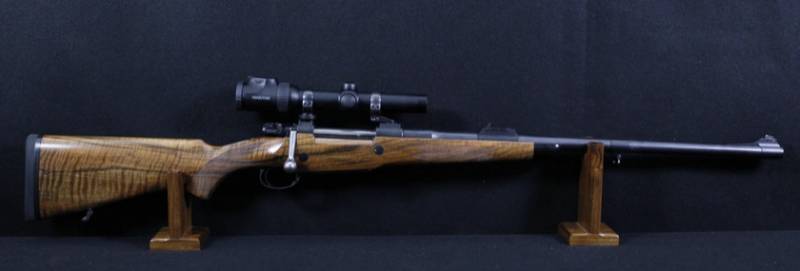
Hunting rifle Mauser M 98 Magnum
The Mauser M 98 Magnum carbines are available in .375 Holland & Holland Magnum with 5 + 1 magazine capacity, .416 Rigby and .450 Rigby with 3 + 1 or 4 + 1 magazine capacity. ammunition. Weight without cartridges - 4,4 kg. Table length - 620 mm. The total length is 1 mm.
The price of the base model Mauser M 98 in Germany starts from 6 euros. But the use of expensive options and additional finishes can increase the cost many times over.
In Russia, a basic carbine chambered for 8 × 57 IS costs more than 3 million rubles.
Продолжение следует ...
Information